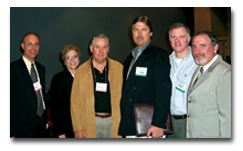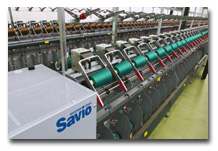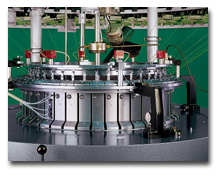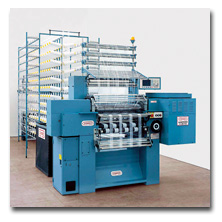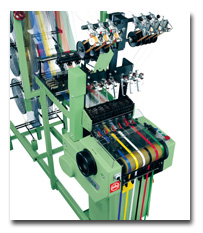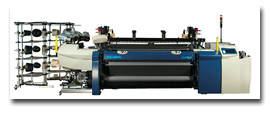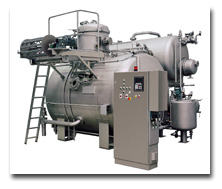Executive ForumBy James A. Morrissey, Washington Correspondent Moore’s Perspective
New ATMI chairman urges more industry unity.

Willis C. Billy Moore, executive vice president and CFO of Unifi Inc., Greensboro, N.C., and
newly elected chairman of the American Textile Manufacturers Institute (ATMI), Washington, shared
with Textile World his perspective on where ATMI and the textile industry are headed.TW: As you
assume the chairmanship of ATMI, what do you see as the major challenges facing ATMI and the
textile industryMoore: ATMI has clearly spelled out our answers to the major challenges facing the
US textile industry in the eight-point Textile Action Plan released in January. It addresses a
number of issues related to the Doha round of global trade negotiations and points out the problems
we are facing as a result of the overvalued US dollar and currency manipulations by certain foreign
governments. The action plan says that our government must reject further non-reciprocal trade
expansion, impose quotas in response to surges in imports from China and include strong textile
protection provisions in any future trade agreements. It also says that the US textile industry is
not to be used as a bargaining chip in support of allies in the war on terrorism, and it urges a
number of actions with respect to customs enforcement and intellectual property protection.
Clearly, this is a far-reaching agenda that touches all sectors of our industry. In my
conversations with other industry leaders, I have found support for ATMIs Textile Action Plan to be
virtually unanimous. Now we have to work together to get our government to support it.TW: Do you
believe the Bush administration is sufficiently supportive of the US textile industryMoore:I think
its a work in progress. I know it is saying the right things, but its first interim report to
Congress last September made it clear that much remains to be done. As Commerce Secretary Donald L.
Evans said at last years ATMI annual meeting, we have to judge [the administration] by the results,
not just the word. I believe many key people in the Bush administration recognize the problems we
face but there are some who arent there yet, and we need to fix that. And we need to work to get
consistent textile trade policies. For example, it makes absolutely no sense for the administration
to encourage US textile companies to seek trading partnerships with the countries of the Caribbean
and Andean regions, then turn around and put forth a tariff proposal that would negate the benefits
of such preferential trade agreements. We remain optimistic that the Bush administration will keep
its commitments to textile leaders; however, we are concerned by the lack of concrete results. US
Trade Representative Robert B. Zoellicks Doha round tariff proposal could devastate what remains of
our industry if adopted in its current form, and we need a strong, clear proposal from our
government to eliminate non-tariff trade barriers.TW: As the industry shrinks, is its influence in
Congress weakenedMoore: That is a natural assumption that some people make because the industry has
contracted, but we feel that this does not necessarily translate into weakness in Congress. The
textile industry is a major manufacturing base in regions where it has traditionally been strong,
and we have the firm support of a dedicated group of representatives and senators. Although some
long-time supporters in Congress have retired, we have every reason to believe that the members who
replaced them will be outspoken and effective advocates for our industry. If we can get all sectors
within the industry pulling together, we can maintain or even expand our base of support in
Congress. But we cant do it if we fight amongst ourselves. We need to have greater unity, and I
think the American Textile Alliance can serve as the foundation for such unity.TW: There is
widespread agreement that textiles has become a global industry. What should ATMI do to help
textile companies become more globally orientedMoore: We continue changing the mindset of this
industry. For too long, many of us have relied upon a fortress America approach, counting on our
government to keep foreign products out of the US market so we could have it all to ourselves. We
didnt need to export because we had this great market. Our member companies need to recognize that
free trade is here to stay, and in order to survive, we must learn to be globally competitive in
all phases of our business. We have to find new export markets, and we must make sure our
government helps us get the opportunities to export. Id like for President Bush to paraphrase
Ronald Reagan and dare these other countries to tear down their walls erected against our
products.TW: Some people say ATMI should become more involved in trade and sourcing shows and
similar export promotion activities. Should this involvement have a higher priority on ATMIs
agendaMoore: The ATMI Board of Directors has explored this issue previously, and the overwhelming
sentiment seemed to be this should not be ATMIs mission. If our members change their minds, we
would set out in that direction; but for now our members continue to believe that ATMI can best
serve the industrys needs by laying the foundation in Washington for a more successful business
climate in which they can compete. Our members can create their own opportunities they just need a
climate for success.TW: At the present time, ATMI seems to be anything from lukewarm to negative on
a free trade agreement with Central America. Your company has been aggressive in promoting the
Caribbean Basin Initiative and Central American trade through the Jassin ORourke Group education
program. Could this be expanded to encourage more ATMI members to become more involved in those
areasMoore: ATMI has consistently said that any free trade agreement must be fair and beneficial to
US textiles. I agree with this position and am a strong proponent of free trade for the Americas.
However, it must be fair, and free trade agreements must include strict North American Free Trade
Agreement (NAFTA)-type yarn-forward rules of origin, exclude any exceptions that would benefit
non-participating countries, include tariff reductions that are completely reciprocal and provide
that non-tariff barriers to US exports be immediately eliminated. That is our objective in all free
trade agreements, and I will continue to urge that this be the final result. As chairman, I intend
to encourage our members to explore all available opportunities to promote US textile partnerships
and exports.TW: What changes do you foresee in ATMI with respect to membership and its
relationships with other associations For example, there is a perception in some quarters that ATMI
is driven by cotton interests.Moore: I think that ATMIs membership base, which has declined over
the past six to seven years as the industry has contracted, has begun to stabilize and should begin
to grow again as we continue to demonstrate just what we can do on behalf of textile companies. We
have made some progress in that regard, and I intend to work in my term as chairman to make further
progress. I intend to do this by showing all segments of the industry, no matter what they produce,
that ATMI continues to serve their interests. With the challenges the textile industry faces in the
next few years, especially the elimination of the quota system and numerous new trade negotiations,
it is more important now than ever that the textile industry has a strong, unified and active voice
based in Washington. I think our relationship with other trade associations is basically good, but
it could always be better. In the past few years, ATMI and several other trade associations have
experienced an infusion of new blood on the staff level, and I am confident that our new president,
Parks D. Shackelford, and the heads of the other associations will enjoy a long and productive
working relationship.But we in the industry have to set the tone. In the past, there have been too
many public fights over the few issues that divide us. Weve got to make sure that we work out any
differences we have in private and then present a united front. Anything else will only benefit the
importers and foreign manufacturers who would like to drive us out of business. Make no mistake,
public fighting gives aid and comfort to those who are our real enemies, and thats why I am going
to take a page out of Van Mays playbook and commit to working to ensure only positive working
relationships with other associations. Were all in this together, and we all just need to keep that
in mind.
Editor’s Note: Textile World encourages textile executives to speak out on matters affecting
today’s textile industry. To participate in TW’s Executive Forum, e-mail
jborneman@textileindustries.com.
May 2003


